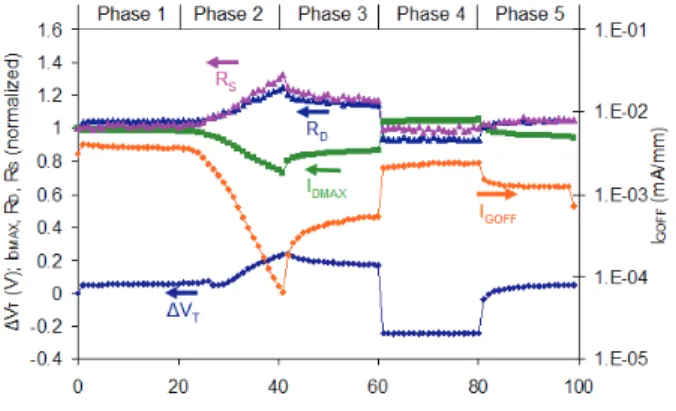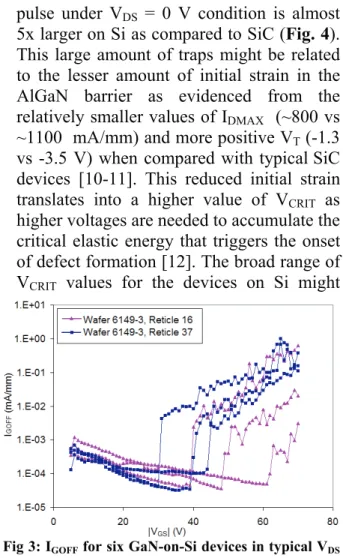Critical Voltage for Electrical Reliability of GaN
High Electron Mobility Transistors on Si Substrate
The MIT Faculty has made this article openly available. Please share how this access benefits you. Your story matters.
Citation Demirtas, S., and J.A. del Alamo. “Critical voltage for electrical reliability of GaN high electron mobility transistors on Si substrate.” Reliability of Compound Semiconductors Digest (ROCS), 2009. 2009. 53-56. © Copyright 2009 IEEE
As Published http://ieeexplore.ieee.org/xpls/abs_all.jsp?arnumber=5313988
Publisher Institute of Electrical and Electronics Engineers
Version Final published version
Citable link http://hdl.handle.net/1721.1/58977
Terms of Use Article is made available in accordance with the publisher's policy and may be subject to US copyright law. Please refer to the publisher's site for terms of use.
Critical Voltage for Electrical Reliability of GaN High Electron
Mobility Transistors on Si Substrate
S. Demirtas and J. A. del Alamo
Massachusetts Institute of Technology, 39-611, Cambridge, MA 02139
sefa@mit.edu; +1-617-253-1620; FAX +1-617-258-7393
Abstract
We have evaluated the electrical reliability of GaN HEMTs on Si by carrying out VDS =
0 V step-stress experiments. We have found that these devices show a degradation pattern that is very similar to that of devices on SiC with a critical voltage at which a sudden degradation of the gate current takes place. In general, devices on Si have a relatively high critical voltage although its distribution on a wafer is fairly broad even on a short-range scale.
Introduction
GaN High Electron Mobility Transistors are promising devices for high power and high frequency applications. SiC is the most broadly used substrate for GaN HEMTs. Recently, Si has emerged as an attractive substrate because of lower cost, availability in large diameters and sophisticated technology base. However, reliability becomes a bigger concern with larger lattice and thermal mismatch between GaN and Si as compared to SiC. This has been reported to cause more defects in GaN-on-Si devices when compared with devices on SiC (2x109 vs. ~108 cm-2 range) [1-2] and results in prominent trapping even before applying electrical stress [3]. Nevertheless, excellent electrical reliability has been reported in GaN on Si HEMTs with a lifetime greater than 107 h at Tj=150 OC at 28 V [4-6].
In this work we study the electrical degradation of GaN-on-Si HEMTs using techniques that we have developed to study
GaN on SiC devices in reverse bias regime [7-8]. In particular, we have step-stressed the devices under VDS = 0 V condition, a
harsh stress condition relative to the targeted operating conditions for these devices. We find a pattern of degradation under these step-stress tests that in several ways resembles that of GaN-on-SiC HEMTs, although there are some salient differences.
Experimental
We studied experimental AlxGa1-xN/GaN
HEMTs on Si with a 17.5 nm thick x=0.26 AlGaN barrier fabricated by Nitronex [4-5]. These devices yield Pout = 3.9 W/mm and
PAE = 62% at 2.14 GHz under VDS = 28 V.
The gate-source and gate-drain separation, and the gate length are 1, 3 and 0.5 ȝm respectively. Although the devices used in this study are engineering devices specially produced for reliability studies, they have capabilities representative of the technology. In the stress experiments performed in this study, the drain is shorted to the source and the gate voltage is stepped down from -5 V to -80 V. The device is at ambient temperature. Since in this experiment, negligible current flows, the device does not suffer from self heating. Throughout the experiment we measure several figures of merit (IDMAX, IGOFF, RD, RS and VT) by
interrupting the stress every 30 seconds. We have contrasted the results from these experiments on GaN-on-Si devices with HEMTs fabricated on SiC substrate that we have studied before under identical
conditions [7-8]. These devices on SiC have a relatively similar barrier design and therefore should constitute a reasonable reference.
Results
Fig. 1 compares the results of a typical
stress experiment in GaN-on-Si HEMT and a GaN-on SiC HEMT as reference. This experiment stops at -40 V. In the GaN-on-Si HEMT from the very beginning of the stress test, RD and RS start increasing and IDMAX
starts decreasing. IGOFF also decreases up to
a certain voltage. In contrast, for the GaN HEMT on SiC, RS, RD and IDMAX remain
stable up to about 20 V of |VGS|. In both
devices, at a certain voltage, there is a relatively sharp rise of the gate leakage current. This is what we term the critical voltage, VCRIT [9].
Below the critical voltage, there is a marked difference in the behavior of both devices. There seems to be degradation in GaN-on-Si even before reaching the critical voltage, while the GaN-on-SiC devices remain stable. In order to understand this apparent degradation below VCRIT, a five-phase
experiment was performed on Si (Fig. 2). Phase 1 consisted of continuous characterization without stress. In Phase 2, VDS = 0 V step stress from VGS = -1 V to -20
V was applied (this is below VCRIT). In this
phase, we see degradation in RS, RD and
IDMAX, consistent with the results in Fig. 1.
In Phase 3, the device was allowed to rest in the dark without stress and the FOMs were observed to recover sluggishly suggesting slow detrapping from deep traps. IDMAX
recovered to 86% of its original value. In Phase 4, detrapping was enhanced with the device at rest but under UV light illumination (365 nm). After turning off UV in Phase 5, IDMAX reached 95% of initial
value. IGOFF is also observed to recover in a
very similar manner.
To further understand this experiment, we have performed current collapse measurements before and after it. These show that there was no significant increase in the number of traps. All together, this indicates that the apparent degradation in GaN-on-Si HEMTs in the stress regime below VCRIT that is observed in Fig. 1 is the
consequence of electron trapping in pre-existing traps in the fresh device. UV is
Fig 1: Typical degradation patterns for GaN-on-Si and GaN-on-SiC HEMTs during a VDS = 0 V
step-stress experiment. VGS is stepped from -5 V by -1 V
steps every 30 seconds. The device parameters are recorded continuously by a benign characterization suit.
Fig 2: A five-phase experiment that investigates degradation on Si when stressed below VCRIT. The
phases are: 1) characterization without stress, 2) VDS
= 0 V step-stress from VGS = -1 V down to -20 V (|VGS| is below VCRIT), 3) recovery in the dark, 4)
recovery under UV light (365 nm), and 5) recovery in the dark again.
effective in recovering the device to its virgin state through electron detrapping. The fact that IGOFF decreases with trapping is
consistent with a gate leakage mechanism through partially filled traps in the AlGaN barrier [8]. When the traps fill up, current conduction is blocked and IGOFF decreases.
The increase in RD and RS and the decrease
in IDMAX stem from the electrostatic
suppression of the 2DEG in the extrinsic region of the device by the trapped electrons. VT also shifts positive consistent
with increased trapping. The fact that no such effects are observed on SiC below VCRIT is consistent with the existence of
fewer traps on SiC in the fresh state compared to Si. Burn-in, as commonly performed in industry [5] might mitigate this problem. We have not investigated this possibility.
A remarkable result is that some GaN HEMTs on Si exhibit high values of VCRIT,
sometimes exceeding 70 V. Similar devices on SiC devices have VCRIT values in the
15-30 V range [7-8]. Another interesting difference is that on Si, the distribution of VCRIT is broad even for devices in the same
reticle (Fig. 3). In our studies, the average VCRIT for VDS = 0 V step-stress experiments
for 59 samples is 37 V with ı=13.1 V. On SiC, we often observed much tighter VCRIT
distributions over a wafer with ı = 1-2 V range.
Discussion
Our observations on Si are consistent with a degradation mechanism for devices on Si that seems similar to the one we have observed in SiC devices: defect formation induced by excessive mechanical stress introduced at high voltages through the inverse piezoelectric effect [7]. The unique aspect of Si is the large amount of trapping centers that virgin devices seem to have. Current collapse right after a -10 V gate
pulse under VDS = 0 V condition is almost
5x larger on Si as compared to SiC (Fig. 4). This large amount of traps might be related to the lesser amount of initial strain in the AlGaN barrier as evidenced from the relatively smaller values of IDMAX (~800 vs
~1100 mA/mm) and more positive VT (-1.3
vs -3.5 V) when compared with typicalSiC devices [10-11]. This reduced initial strain translates into a higher value of VCRIT as
higher voltages are needed to accumulate the critical elastic energy that triggers the onset of defect formation [12]. The broad range of VCRIT values for the devices on Si might
Fig 3: IGOFF for six GaN-on-Si devices in typical VDS
= 0 V step-stress experiments. The distribution of VCRIT is very broad even for devices in close
proximity. Very high VCRIT values are also observed.
Fig 4: Normalized current transients in devices on GaN-on-Si and SiC HEMTs after the application of 1 sec pulse of VGS = -10 V at VDS = 0 V. The current
measured is IDlin, (VGS = 1 V, VDS = 0.5 V). The initial
reflect an uneven distribution of initial strain on the wafer.
Conclusion
We have evaluated the reliability of GaN HEMTs on Si under harsh VDS = 0 V
step-stress conditions. We find that HEMTs on Si exhibit a pattern for degradation that is characterized by a critical voltage, just as devices on SiC. Apparent device degradation for GaN-on-Si HEMTs for stress voltages below the critical voltage is due to traps that already exist in the fresh device and is not real physical degradation. We have also found that VCRIT on GaN on Si
HEMTs can be quite high but with a relatively broad distribution of values on a wafer.
Acknowledgements
This work was funded by a DARPA program (Mark Rosker, program manager) under ARL contract #W911QX-05-C-0087 (Alfred Hung, COTR) and by the Office of Naval Research Grant #N00014-08-1-0655 (Paul Maki and Harry Dietrich). We also acknowledge collaboration with Nitronex Corporation and TriQuint Semiconductor.
References
[1] P. Rajagopal, et al, “Large-Area, Device Quality GaN on Si Using a Novel Transition Layer Scheme,” Mater. Res. Soc. Symp. Proc.
743 p.3 (2003).
[2] R. Quay, Gallium Nitride Electronics, illustrated ed. Berlin: Springer, 2008.
[3] P. Javorka, et al, “Material and Device Issues of AlGaN/GaN HEMTs on Silicon Substrates,” Microelectronics Journal, Volume 34, Issues 5-8 Pages 435-437. 2003.
[4] Piner, E.L. et al, "Device Degradation Phenomena in GaN HFET Technology: Status, Mechanisms, and Opportunities," Electron Devices Meeting, 2006. IEDM '06. International, vol., no., pp.1-4, 11-13 Dec. 2006.
[5] Singhal, S. et al, "Reliability of large periphery GaN-on-Si HFETs," ROCS Workshop, pp. 135-149. 2005.
[6] S. Singhal, et al, "GaN-On-Si Reliability: A Comparative Study Between Process Platforms," ROCS Workshop, pp.21-24. 2006. [7] Joh, Jungwoo; del Alamo, Jesus A., "Mechanisms for Electrical Degradation of GaN High-Electron Mobility Transistors," Electron Devices Meeting, International pp.1-4, 11-13 Dec. 2006.
[8] Joh, Jungwoo; Xia, Ling; del Alamo, J.A., "Gate Current Degradation Mechanisms of GaN High Electron Mobility Transistors," Electron Devices Meeting, International, pp.385-388, 10-12 Dec. 2007.
[9] Jungwoo Joh; del Alamo, J.A., "Critical Voltage for Electrical Degradation of GaN High-Electron Mobility Transistors," High-Electron Device Letters, IEEE , vol.29, no.4, pp.287-289, April 2008.
[10] M. Asif Khan, et al, “GaN-AlGaN heterostructure field-effect transistors over bulk GaN substrates,” Appl. Phys. Lett. 76, 3807 (2000).
[11] N. Maeda et al, “Two-dimensional electron-gas density in AlGaN heterostructure field-effect transistors,” Appl. Phys. Lett. 73, 1856 (1998). [12] Joh, Jungwoo, et al, “A model for the critical voltage for electrical degradation of GaN high electron mobility transistors,” ROCS Workshop 2009.

